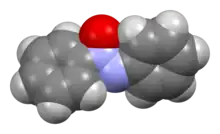 | |
 | |
| Names | |
|---|---|
| Preferred IUPAC name
Diphenyldiazene oxide[1] | |
| Other names | |
| Identifiers | |
| ECHA InfoCard | 100.007.094 |
PubChem CID |
|
| UNII | |
CompTox Dashboard (EPA) |
|
| Properties | |
| C12H10N2O | |
| Molar mass | 198.225 g·mol−1 |
| Appearance | yellow solid |
| Density | 1.318 g/cm3 |
| Melting point | 35.5–36.5 °C (95.9–97.7 °F; 308.6–309.6 K) |
Except where otherwise noted, data are given for materials in their standard state (at 25 °C [77 °F], 100 kPa).
Infobox references | |
Azoxybenzene is organic compound with the formula C6H5N(O)NC6H5. It is a yellow, low-melting solid.[2] The molecule has a planar C2N2O core. The N-N and N-O bond lengths are nearly the same at 1.23 Å.[3]
Preparation
It can be prepared by partial reduction of nitrobenzene. This reaction is proposed to proceed via the intermediacy of phenylhydroxylamine and nitrosobenzene:[2]
- PhNHOH + PhNO → PhN(O)NPh + H2O
Another option is the oxidation of aniline by hydrogen peroxide, in acetonitrile at 50 °C. In this reaction, the pH should be kept around 8, to activate the hydrogen peroxide and avoid too much oxygen evolution at the same time. First, the acetonitrile is oxidized, forming an imine hydroperoxide. Then, this intermediate oxidizes the aniline to azoxybenzene. [4]
- CH3CN + H2O2 → [CH3C(OOH)=NH]
- 2 PhNH2 + 3 [CH3C(OOH)=NH] → PhN(O)NPh + 3 CH3C(O)NH2 + 2 H2O
- PhNO2 + Na3AsO3/NaOH→ Ph−N+O−=N-Ph
References
- 1 2 3 4 Nomenclature of Organic Chemistry: IUPAC Recommendations and Preferred Names 2013 (Blue Book). Cambridge: The Royal Society of Chemistry. 2014. p. 1009. doi:10.1039/9781849733069-00648. ISBN 978-0-85404-182-4.
- 1 2 H. E. Bigelow; Albert Palmer (1931). "Azoxybenzene". Organic Syntheses. 11: 16. doi:10.15227/orgsyn.011.0016.
- ↑ S. P. G. Martínez; S. Bernès (2007). "trans-Diphenyldiazene Oxide". Acta Crystallographica Section E. 63 (8): o3639. doi:10.1107/S1600536807035787.
- ↑ George B. Payne; Philip H. Deming; Paul H. Williams (1961). "Reactions of Hydrogen Peroxide. VII. Alkali-Catalyzed Epoxidation and Oxidation Using a Nitrile as Co-reactant". The Journal of Organic Chemistry. 26 (3): 659-663. doi:10.1021/jo01062a004.
This article is issued from Wikipedia. The text is licensed under Creative Commons - Attribution - Sharealike. Additional terms may apply for the media files.